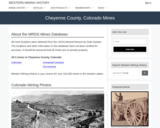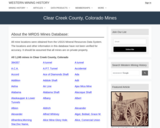
This textbook is designed to supplement a GER class for non-science majors in college.
- Subject:
- Chemistry
- Physical Science
- Material Type:
- Case Study
- Reading
- Textbook
- Provider:
- LibreTexts
- Date Added:
- 05/02/2023

This textbook is designed to supplement a GER class for non-science majors in college.

This Western Mining History database uses Mineral Resources Data System to list known Colorado historical mines by county. Each county site has links to the known mines within its borders. Some are known and named, others are unnamed. Mines should be assumed to be on private property unless other research is conducted. Data provided for each mine site include: Name, State, County, Elevation, Primary Mineral Mined, Latitude and Longitude and a link to Google Maps. Photos are provided where available. Additional information for some Mines are satellite photos, and ownership, business and historical records. Mining History is an historical site that provides information on mining, mining towns, the gold and silver rush, and Photos and maps of the western United States. This is a great database for student historical research or data and statistics classes. Consider becoming a member or making a donation to help further the work of the site.

In this video clip from Earth: The Operators' Manual, host Richard Alley discusses China's efforts to develop clean energy technologies and to reduce CO2 in the atmosphere, by building coal plants using CO2 sequestration technology. (scroll down page for video)

In this report funded by the World Bank and carried out by the firm PRTM, China's New Energy Program and 10 Cities 1000 Vehicles program are evaluated. China is on the forefront of electric vehicle (EV) and hybrid electric vehicle (HEV) development leading the world in funding of new energy vehicles (100 billion RMB investments by 2021). Leading the development of new energy technologies is faced with challenges such as policy, grid solutions, standards, new business models, new technologies, and customer acceptance. This report reviews China's current energy programs and predicts future government and commercial changes to come due to new energy technologies.

As the Rolling Stones song says, "You can't always get what you want." So we make choices. Every day, governments and individuals choose how much money to spend and what to purchase. The January 2013 issue discusses opportunity costs and scarcity and how they effect our spending decisions.

ofrece las ltimas noticias de la ciencia. La clase de jueves proporciona nuevos planes y actividades de la leccin basados en una historia actual del ttulo y conecta la ltima investigacin de NASA con la instruccin. Pasados asuntos incluyen Buck Rogers, Cuidado!, Adis a la MIR, Despus de tres intentos, se retira La Nia?, y ms.

An interactive applet and associated web page defining a circle. The applet shows a circle where the user can drag the center and a point on the circle. The radius line supports the definition that all points on the circle are a fixed distance from the center. The web page has the definitions of all the circle-related objects, such as diameter, chord etc, with links for each. Applet can be enlarged to full screen size for use with a classroom projector. This resource is a component of the Math Open Reference Interactive Geometry textbook project at http://www.mathopenref.com.

Welcome to the CIRCLE OF STORIES lesson plans. These lessons will allow students to examine the complex and rich oral tradition of Native American storytelling, create their own stories to share, explore indigenous and Native American cultures and the issues which face them today, and research and explore their own cultural heritage by recording their unique family stories and heritage. These lessons are directed toward grades 6 through 12, for use in the following subject areas: language arts, theater, history, social studies, multicultural studies, technology, and life science.

An interactive applet and associated web page that show the properties of a circumcircle of a polygon. The applet shows a regular polygon where the user can drag the vertices to reshape it and alter the number of sides. As the polygon is being varied, the circumcircle is shown, passing through all vertices. The text describes two ways to calculate the radius of the circumcircle, depending on what you are given to start. Applet can be enlarged to full screen size for use with a classroom projector. This resource is a component of the Math Open Reference Interactive Geometry textbook project at http://www.mathopenref.com.

An interactive applet and associated web page that demonstrate the circumference of a circle. The applet shows a circle with a radius line. The radius endpoints are draggable and the circle is resized accordingly. The formula relating radius to circumference is updated continually as you drag. Introduces the idea of Pi. The formula can be hidden for class discussion and estimation. See also the entries for circumference and diameter. See also entries for radius and diameter. Applet can be enlarged to full screen size for use with a classroom projector. This resource is a component of the Math Open Reference Interactive Geometry textbook project at http://www.mathopenref.com.

The COR curriculum provides free lessons and assessments that help you teach students to evaluate online information that affects them, their communities, and the world.

A new and annotated translation of the French Prime Minister’s memoir of his friend, the most famous Impressionist painter.

This Western Mining History database uses Mineral Resources Data System to list known Colorado historical mines by county. Each county site has links to the known mines within its borders. Some are known and named, others are unnamed. Mines should be assumed to be on private property unless other research is conducted. Data provided for each mine site include: Name, State, County, Elevation, Primary Mineral Mined, Latitude and Longitude and a link to Google Maps. Photos are provided where available. Additional information for some Mines are satellite photos, and ownership, business and historical records. Mining History is an historical site that provides information on mining, mining towns, the gold and silver rush, and Photos and maps of the western United States. This is a great database for student historical research or data and statistics classes. Consider becoming a member or making a donation to help further the work of the site.

Students are read a series of two options and are asked to decide which options are more dangerous. They then learn about risk and how to prevent or reduce risk by taking precautions. Next they listen to a story about risk, where Clifford, the big red dog, helps reduce the risk of danger by taking precautions. After the story, the students complete a story sequencing activity based on Clifford’s actions. Finally, they recognize that Clifford does not exist in the real world and talk about people in their families and communities that help protect them from risk.

In this short video, learn about actions that humans can take to mitigate climate change and adapt to its impacts. Use this resource to stimulate thinking and questions about climate change and to provide opportunities for students to design solutions and communicate information.

This video discusses how the populous areas west of the Andes are largely desert and rely on glacial meltwater as an important source of fresh water. Because the Peruvian glaciers high in the Andes are in rapid retreat, scientists are monitoring the steadily shrinking glaciers and the impact of their reduction on local populations.

This graphic indicator measures drought conditions of U.S. lands.

This graphic indicator describes trends in average precipitation for the United States and the world.

This video focuses on the science of climate change and its impacts on wildlife on land and in the sea, and their habitats in the U.S. There are short sections on walruses, coral reefs, migrating birds and their breeding grounds, freshwater fish, bees, etc. Video concludes with some discussion about solutions, including reduce/recycle/reuse, energy conservation, backyard habitats, and citizen scientists.

This video addresses how climate change is affecting the biomes and ecosystems in the US Pacific Northwest, Alaska, Hawaii and the Caribbean Islands. It also highlights the impacts on infrastructure and defines key climate science terms.